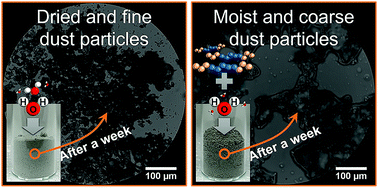Liquid amphiphilic polymer for effective airborne dust suppression†
Abstract
Airborne dust is a byproduct of natural and artificial occurrences, including high winds in arid regions and human activities, and it affects most of the world's population. Watering is the most general practice for reducing airborne dust by wetting the surface of the dust source to agglomerate dust particles via the capillary effect, increasing the aerodynamic diameter of (ultra)fine particles and reducing dust emission. However, the short-term effectiveness due to fast water evaporation, requiring frequent watering, is a major disadvantage. Herein, we utilized biocompatible liquid polymers as additives in water to prolong moist conditions of dust sources due to their liquid state. After the water evaporated, the liquid polymers maintained moisture on the dust sources, resulting in significantly reduced (ultra)fine particle emissions and extended effectiveness compared to conventional water treatment. Interestingly, we observed greater dust suppressive effectiveness with liquid amphiphilic polymer than liquid hydrophilic polymer because of the synergistic effect of the liquid state and amphiphilic property of the polymer. Translating lab-scale experiments to pilot-scale field-testing confirmed the potential for utilizing biocompatible liquid amphiphilic polymers to advance airborne dust suppression technology.

- This article is part of the themed collection: Polymers in liquid formulations


 Please wait while we load your content...
Please wait while we load your content...